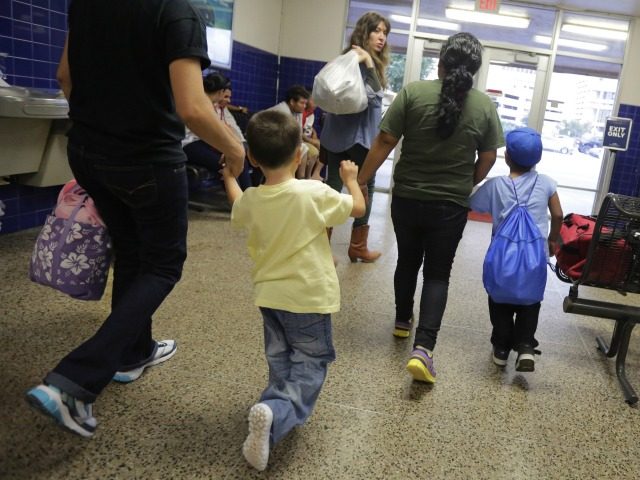The pro-migration ACLU is suing the Department of Homeland Security to help economic migrants use children to smuggle themselves into the United States.
President Donald Trump’s DHS tries to detain all migrants pending their asylum hearing because it is easier to repatriate migrants homewards when they lose their hearing. The detention policy is also intended to prevent migrants from walking away and then disappearing into the United States, and also to deter future migration.
When groups of migrants — the so-called “family units” of adults and children — appear at the border, DHS prioritizes its limited number of detention beds for the adults. The accompanying children are safeguarded in other housing run by the Department of Health and Human Services.
Overall, the detention policy is intended to end the practice of “catch-and-release,” which happens when border officers are forced to let asylum-seeking migrants go free because there are no available beds at the detention sites.
But the pro-migration ACLU is trying to knock down barriers again migration from Central America, South America, Asia, and Africa.
“Whether or not the Trump administration wants to call this a ‘policy,’ it certainly is engaged in a widespread practice of tearing children away from their parents,” said Lee Gelernt, deputy director of the ACLU’s Immigrants’ Rights Project. “A national class-action lawsuit is appropriate because this is a national practice.”
The DHS policy is needed to help prevent smugglers using children as legal props to help their clients get past the border patrol, countered a statement from Tyler Houlton, Acting DHS Press Secretary. He said:
DHS does not currently have a policy of separating women and children. However, we retain the authority to do so in certain circumstances – particularly to protect a child from potential smuggling and trafficking activities.
For example: There have been numerous intelligence reports and cases where kids have been used and trafficked by unrelated adults in an effort to avoid detention. It is the US Government’s responsibility under the HSA of 2002 and the TVPRA that we ensure the child is not a victim of trafficking and they are with a bona fide parent or legal guardian. If we are unable to confirm this relationship we must take steps to protect the child, which may result in placing them with HHS as an unaccompanied child.
If we were to fail in this regard we could be responsible for allowing a child to be released to a trafficker, which is clearly unacceptable.
Due to privacy concerns – for adults and especially children – we are often unable to share details of these cases. We ask that members of the public and media view advocacy group claims that we are separating women and children for reasons other than to protect the child with the level of skepticism they deserve.
In related efforts, DHS is asking Congress for funds to operate almost 45,000 beds, up from the current level of roughly 33,000 beds. Justice Department officials are trying to end the catch-and-release policy by streamlining the asylum process, which doubled to roughly 660,000 people under former President Barack Obama.
Attorney General Jeff Sessions described the problem in October 2017. He said:
The system is being gamed, there’s no doubt about it … We can close loopholes and clarify our asylum laws to ensure that they help those they were intended to help. As this system becomes overloaded with fake claims, it cannot deal effectively with just claims.
The ACLU lawsuit is built on prior legal victories by open-borders groups. For example, Obama’s deputies agreed to a 20-day cap on keeping children in detention centers, effectively giving the adults a free get-out-f-detection card after 20 days.
The ACLU lawsuit is focused on a media-friendly example. According to a March ACLU statement:
The filing broadens an existing ACLU lawsuit seeking to reunite an asylum-seeking mother and her 7-year-old daughter fleeing violence in the Democratic Republic of Congo, only to be forcibly torn from each other in the U.S. and detained separately 2,000 miles apart. Earlier this week, the government abruptly released the mother, who is waiting to be reunited with her daughter.
Under the long-standing international law, asylum-seekers are expected to apply for asylum in the first safe nation they reach. However, an increasing number of Africans and Asians are migrating through many sate s– including Brazil and Mexico — to reach the United States.

COMMENTS
Please let us know if you're having issues with commenting.